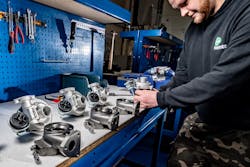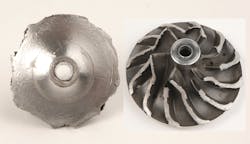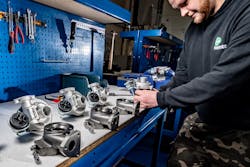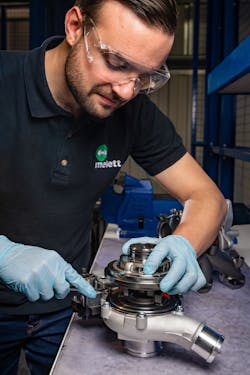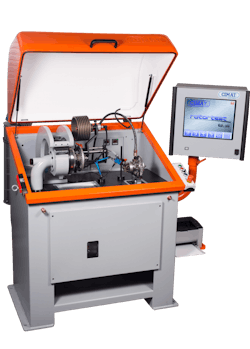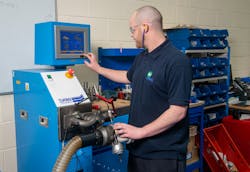Content brought to you by Motor Age. To subscribe click here.
What you will learn:
•The root cause for turbocharger failure must always be found
•Turbochargers are typically blamed for driveability faults, but rarely the cause
•Turbocharger repair is a specialized job and requires precision balance
Despite the constant press coverage of new, or soon-to-be-launched all-electric vehicles, gasoline, and diesel-powered cars and light trucks will be around for some time to come. In 2021, 38 percent of all new vehicles sold in the U.S. have a turbocharged engine. And as miles accumulate on these vehicles, many will require turbocharger replacement.
Poor engine performance, and/or turbo related DTCs are too often blamed on the turbocharger, which is only at fault about 20 percent of the time. If the turbocharger is at fault, the root cause of the failure should be determined (Figure 1). After all, if a customer’s car has a dead battery, only an inexperienced technician would replace the battery without figuring out why it has no charge—bad alternator, wiring or sensor could all contribute to the problem. Finding the root cause of a turbo failure is no different.
Once the turbo is determined to be “bad,” there are alternatives to replacing it with a new OEM unit. The aftermarket can supply new turbos, re-manufactured turbos, or rebuild a core that is shipped to them and offer better than OEM quality with a price point considerably lower than a new OEM turbo.
Finding the Root Cause
In addition to turbo related DTCs, a visual inspection can help to determine why a turbo has failed before it’s removed from the engine. If the compressor wheel blades are rounded off, inspect the air filter and ducting for leaks. If either the compressor, or turbine wheels show signs of blades rubbing on the compressor/turbine housings, or if blades are broken suspect a lubrication problem.
An often, overlooked cause of lack of lubrication is a blocked oil inlet (Figure 2). The turbo oil feed pipe may have been "cooked" due to repeated hot shutdowns that can cause carbon deposits to block the feed line. If the turbo has a water-cooled center housing rotating assembly (CHRA) check water lines for restrictions that can cause over-heating.
A quick, go-no-go inspection of the bearings can be done by slowly rotating the compressor wheel to feel if it contacts the housing. Some “play” is normal, but if the compressor blades rub on the housing the bearings need to be replaced. A visual inspection of this condition will show flat edges on the compressor blades where they've rubbed on the housing. This test also works on the turbine side of the turbo.
Aftermarket Turbo Replacement
If a turbocharger replacement is needed, consider using a quality aftermarket supplier as a cost-effective alternative to a new OEM unit. Melett Limited is based in the UK with worldwide distribution to over 100 countries including Melett North America located in Memphis, Tenn. The company offers replacement turbochargers (includes gaskets and fasteners), center housing rotating assemblies, and individual repair parts to the independent aftermarket (Figure 3).
Located in Virginia, Tim’s Turbos has been rebuilding turbochargers since 2002. Independent auto repair shops can ship a turbo to the company, where it will be disassembled, and the root cause of failure determined. All reusable parts are inspected and measured for signs of wear, castings are deburred, oil passages are inspected, and all parts are ultrasonically cleaned. The rotating components are balanced to better than factory specifications. The rebuild turbo will be shipped back ready to install.
Don't Try This at Home!
Dissembling a turbocharger, and putting it back together is not difficult. However, getting all the parts to “cooperate” when spinning at speeds upwards of 300,000 rpm, and an exhaust gas temperature of 1500 degrees F is a challenge. Your shop may only see a few dozen turbos in a year while a professional turbo rebuilder will work on hundreds, if not thousands each month and has the knowledge and experience to successfully recondition a turbo to like-new condition (Figure 4).
Another advantage of using a reputable turbo rebuilder is that they will communicate with the shop that sent in the turbo and let them know what was discovered as the root cause of failure. They will disassemble the turbocharger, looking for indications of heat damage or scoring on turbine shaft bearing surfaces caused by: dirty oil, low oil pressure, carbon deposits inside the CHRA, and/or a blocked/restricted oil drain tube. They also check for cracking on all castings. In addition to knowing what they are doing rebuilders will have two pieces of equipment not found in a typical automotive repair shop, a vibration sorting rig (VSR), or another type of balancer and a turbo flow bench. Both are recommended for successful rebuilds (Figure 5).
It’s a matter of balance
Rotating components inside a turbocharger have a certain amount of imbalance that creates vibration at various rpm. The center housing rotating assembly (CHRA) contains the turbine shaft wheel, compressor wheel, bearings, and seals. Depending on the size of the turbo the rotating components within the CHRA reach speeds between 60,000 and 300,000 RPM under full boost operation. For comparison, a typical automotive tire rotates around 840 rpm at 60 mph and 1,120 rpm at 80 mph. It's hard to imagine a tire dealer that sells tires without balancing them and a turbocharger rebuilder is no different. As part of the reconditioning process, rotating turbo components must be balanced.
The turbine and compressor wheels are precision-engineered and balanced on specialized equipment as part of the manufacturing process. When joined together, the assembly is called a rotor and the accumulation of the remaining tiny imbalance in the parts can create an out-of-balance rotor that will vibrate at critical speeds.
Balance can be restored by running the CHRA at high speeds (100,000 to 250,000 rpm) on a VSR that measures vibration response. The amount of imbalance is indicated by a “clock” position on a monitor. Imbalance is corrected by changing the assembly position of the compressor wheel or removing metal from either the turbine or compressor wheel.
Failure to balance the CHRA can cause excessive vibrations as the turbo speeds up, resulting in noise (whistling) and a breakdown of the oil film in the bearings. This in turn will cause premature failure of the bearing system, often with no obvious signs of lack of lubrication or oil contamination. The turbo will make unacceptable noise during operation and fail within hours or days of use.
Optimizing exhaust gas flow
The other piece of equipment that a turbo rebuilder has is a turbocharger flow bench (Figure 6). The flow bench is required after rebuilding a variable nozzle turbocharger (VNT) to calibrate the actuator that controls the turbine vanes. Also known as a variable vane turbo, the design balances low-speed turbine response with high-speed efficiency.
The movable turbine vanes change the exhaust gas inlet area to match the engine’s speed and boost requirements (Figure 7). For low-speed response an actuator moves the nozzle vanes towards the closed vane position, to reduce the nozzle area. This increases exhaust gas speed through the turbine providing improved turbo speed response (less turbo lag) at low engine speeds—just like putting your thumb partially over the end of a garden hose to increase the force of a jet of water. As the engine speed increases, the actuator moves the nozzle vanes to the fully open position to maximize exhaust gas flow and reduce exhaust restriction of the engine.
Introduced in the 1990s, VNT turbos are now found on most diesel engines for both passenger cars and trucks. There are a few gasoline engines that use this technology, such as the Porsche Boxster S, Cayman S, and Suzuki's Swift Sport.
The controller’s actuator arm measurement is often set against a cast finish on the bearing housing not accurately controlled in the manufacturing process. During the manufacture of a new VNT turbo, vane positions are set using accurate airflow equipment that allows a specific mass of exhaust gas to flow through the vanes. Without the use of a turbo flow bench, engine performance will be lacking after turbo replacement and could result in a comeback.
As engine management technology progresses many vehicles control the VNT through an electronic actuator that provides positional feedback to the ECU. Some more advanced turbo controllers are part of the CAN bus system and communicate directly with fuel injection computers and air mass sensors to respond quickly to engine power demands. For these vehicles the VNT actuator settings are critical, and if incorrect, could result in warning lights, limp-in modes, and/or no-start conditions.
Rebuilding, or remanufacturing a turbocharger requires experience, skill, and special equipment. When faced with a turbo replacement independent repair shops should consider the aftermarket as a reliable, cost-effective source for new or rebuilt turbochargers.
Figures 1, 2, 3, 4, and 6 provided by Melett.
About the Author

Tracy Martin
Tracy Martin writes for Motor Age, Aftermarket Aviation Defense, Contact! and Turbo Diesel Register magazines. As an ASE certified master technician and consultant, he has worked in the automotive aftermarket for over 25 years and has provided consulting services for Snap-On Tools, Sun Electric, Chevron Oil and Nissan of North America. He has developed automotive/powersports curriculum and taught courses including: engine performance, automotive electronics, fuel injection, ABS braking systems and advanced motorcycle riding techniques. He has also provided consulting services as an expert witness for automotive and powersports-related court actions.
He is the author of five books: How to Diagnose and Repair Automotive Electrical Systems, Motorcycle Electrical Systems–Troubleshooting and Repair (two editions), How to Use Automotive Diagnostic Scanners (two editions) and How to Modify Motorcycle Fuel Injection, all published by Motorbooks International.
